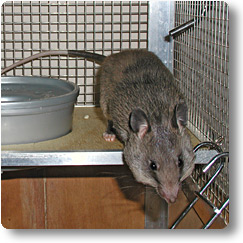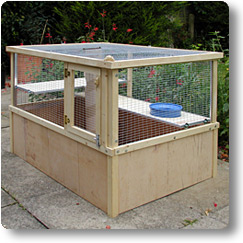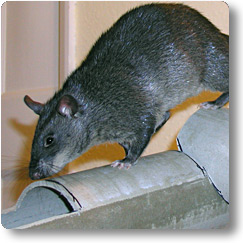Housing African Pouched Rats
Finding a suitable cage

I built my rats’ houses because I couldn’t find a suitable one to buy. Most cages in pet shops are too small. The few that are large enough have wire mesh floors and shelves. Wire mesh is not good for a Pouched Rat's feet. I also wanted something that was easy to clean out and would prevent the rats from throwing their litter and food out onto the carpet. I'd previously built rat-proof cages for domestic rats so I set about scaling up the basic layout and finding ways of making it stronger.
I have built several versions of the cage over the last few years to accommodate changing needs. I wanted to be able to take my rats on holiday so I needed a house that would pack flat. I scaled up the design to provide enough space for a pair of rats and then had to separate it into two when another pair didn’t get on. Through all the modification the basic design has stayed the same.
I’ve provided details of how I built the cages and the materials used for anyone who wants to built something similar.
House for a single rat

This house is built from wood, aluminium and wire mesh. It has a floor area of 100 x 75 cm and is 80 cm high. The ground floor area has enclosed sides to prevent drafts and stop the rats throwing things out. The tops of the side walls are wire mesh. A metal parrot ladder leads to the first floor which runs the full length of the house. This floor has a large hole cut in it which holds the rat’s potty. A small step up leads to the second floor which runs the full width of the house and is where the food bowls are put. The very top level also has a hole cut in it to take a 10 cm cardboard tube which goes all the way down to the ground floor - a rat equivalent of a fireman’s pole. The tubes are supplied by a friendly carpet fitter and they last about three days before they need replacing. The roof, which was originally made of mesh, is now solid after Babu tragically fell while climbing upside down from the roof.
Each level of the house is a separate section which simply slot into the next. The bottom section consists of the main floor area with solid sides. The second section consists of the upper wire mesh sides and the final section is the roof.
All the sections, levels, ladders and tubes simply slide into place and are secured with wing nuts. This not only helps when cleaning and transporting but it also means that I can replace any parts which get destroyed.
 Details of how
its made and how it works are available for anyone who want
build something similar.
Details of how
its made and how it works are available for anyone who want
build something similar.
Travel house
For going away on holiday I built a flat-pack house. It is slightly smaller than the single rat house and, as the name suggests, it packs flat for east transport.
Details of how its made and how it works are available for anyone who want build something similar.
Litter and bedding
I line the base of the houses with sheets of newspaper about six sheets deep and then put in about 10–20cm depth of chopped cardboard. I also add a dozen extra sheets of newspaper torn into strips which the rats use to make their nest.

Toys and enrichment
Pouched Rats are intelligent and need plenty of enrichment to stop them getting bored. Their houses are fitted with a range of obstacles and playthings such as a high level rope walkway, a hanging knotted rope and three interlocking rope hoops for climbing up. These are all parrot toys and I chose natural, uncoloured rope in case the dyes or the synthetic materials were harmful. I encourage the rats to climb up them by hiding food on them.
